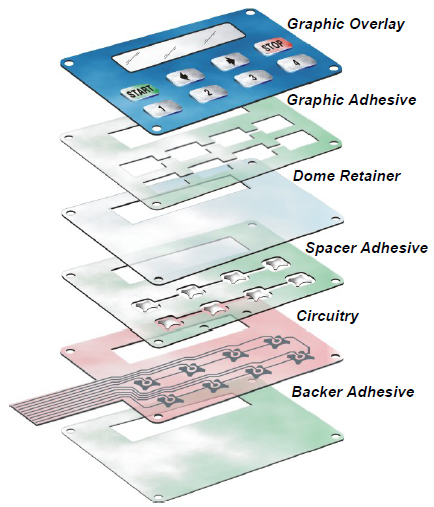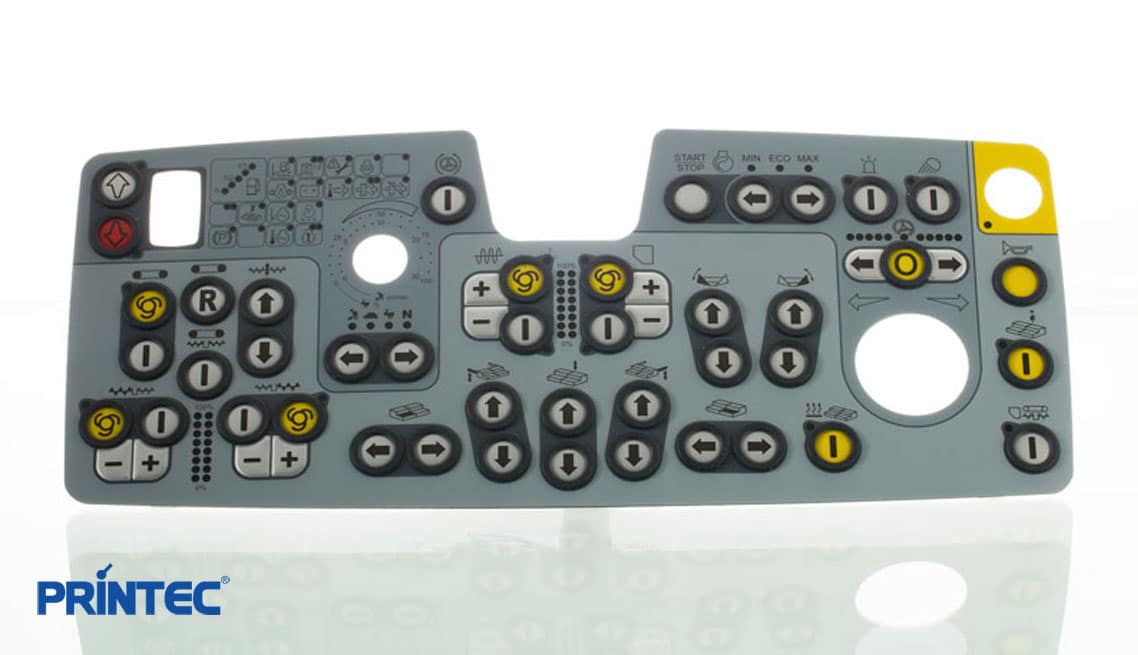If durability matters, sourcing from a reliable membrane switch manufacturer is crucial.
All About Membrane Layer Change: Recognizing Its Style and Performance
When you consider the control interfaces in modern tools, membrane buttons often come to mind. These parts are greater than just buttons; they mix design and capability effortlessly. Comprehending how they function and what makes them effective can transform your perspective on everyday electronic devices. But, there are nuances to their layout and performance that you could not know. Let's explore what collections membrane changes apart from various other control systems.
What Are Membrane Buttons?

Membrane layer buttons can additionally be personalized regarding shape, size, and graphics, allowing manufacturers to produce distinct interfaces customized to certain products. Generally, membrane switches play a significant role in boosting user experience across a broad array of applications.
Exactly How Membrane Changes Work
When you push a secret on a membrane layer button, it triggers a straightforward yet efficient device. The top layer, often constructed from flexible product, lowers onto a conductive layer underneath it. This action bridges the space between conductive traces, completing an electric circuit. As quickly as the circuit shuts, it sends out a signal to the device's controller, which analyzes your input.
You'll observe that the responsive responses varies based upon the switch style, offering either a soft click or an extra obvious feedback. As soon as you release the trick, the membrane go back to its original position, reopening the circuit and stopping the signal. This process takes place nearly instantaneously, guaranteeing a receptive customer experience.
Membrane layer buttons are popular because of their sturdiness and resistance to dust and dampness, making them perfect for numerous applications, from house appliances to medical gadgets. Understanding this procedure aids you value their prevalent usage.
Key Elements of Membrane Switches
Understanding the essential parts of membrane switches is essential for comprehending their performance and style. At the core, you'll locate the visuals overlay, which supplies the visual interface for customers. Below that, there's a spacer layer that separates the circuit layers, guaranteeing that they don't make call until pressed. The circuit layer is where the magic happens; it consists of conductive traces that complete the circuit when you press the switch. An additional important element is the adhesive support, enabling the switch to abide by surfaces firmly. Finally, the safety layer shields against ecological factors and put on, extending the button's life-span. Each component plays a substantial role in making sure trusted efficiency and customer interaction. By comprehending these elements, you'll acquire understanding right into just how membrane switches over run and their significance in various applications.
Products Made Use Of in Membrane Switch Layout
The performance and durability of membrane layer changes heavily rely on the materials made use of in their style. You usually run into polyester and polycarbonate as primary substratums due to their site here exceptional stamina and versatility. see post These materials withstand scrapes and chemicals, making them perfect for requiring settings.
The conductive layers typically use silver or carbon, chosen for their dependability and conductivity. membrane switch manufacturer. Silver offers exceptional performance, while carbon is a cost-efficient alternative. For the overlay, you might think about a matte or glossy coating, depending upon your aesthetic demands and user experience
Adhesives play an important function too; they bond layers firmly and ensure long life. Make particular to pick adhesives that withstand ecological aspects like temperature level and moisture. Ultimately, do not neglect the relevance of a great printing technique for graphics, as it improves both functionality and visual allure. Selecting the ideal materials will guarantee your membrane switch stands the test of time.
Layout Considerations for Membrane Switches
While making membrane buttons, it's crucial to take into account numerous aspects that influence their capability and individual experience. Beginning by concentrating on the design and button dimension; make certain they're user-friendly and easy to browse.
Do not neglect the visuals layout; clear labeling and color comparison are substantial for presence. Confirm your layout accommodates ecological variables, like moisture or temperature variants, which could impact efficiency. Keep in mind the value of screening prototypes with real customers to collect responses and make necessary adjustments. This repetitive procedure helps you refine the design, confirming it fulfills both useful and aesthetic needs efficiently. By thoroughly taking into consideration these aspects, you'll create a membrane switch that improves use and contentment.
Applications of Membrane Layer Buttons
Membrane layer switches are flexible parts found in numerous applications, from commercial devices to consumer electronics. You'll see their influence in equipments that call for resilient user interfaces and in tools that take advantage of streamlined layouts. Comprehending these applications helps you value the functionality and functionality of membrane layer buttons in everyday technology.
Industrial Equipment Use
When you're looking to improve the performance of commercial equipment, membrane layer switches provide a trusted option that combines toughness with easy to use layout. These switches are perfect for rough atmospheres, giving resistance to dirt, moisture, and chemicals. Accept membrane layer buttons to streamline your operations and enhance total efficiency.
Customer Electronic Devices Integration
In the domain name of customer electronic devices, membrane buttons play a crucial role in boosting customer communication and gadget capability. You'll locate them in tools like microwaves, remote controls, and pc gaming consoles, offering a smooth method to interact with innovation. Their streamlined design enables easy integration into numerous products, making controls intuitive and user-friendly. With their ability to integrate graphics and backlighting, you can take pleasure in a contemporary aesthetic that complements the device's total appearance. Membrane switches likewise ensure longevity and resistance to dirt and wetness, extending the lifespan of your electronic devices. By selecting membrane layer buttons, you improve not simply the capability yet also the design of your gadgets, making everyday communications smooth and delightful.
Benefits and Disadvantages of Membrane Buttons
While membrane switches offer a variety of benefits, they why not check here also come with some drawbacks that you need to consider. One significant advantage is their small layout, making them suitable for space-constrained applications.

Membrane switches can have a shorter lifespan contrasted to mechanical buttons, specifically under hefty use. They can also be much less tactile, which may impact individual feedback throughout operation. Balancing these pros and disadvantages will aid you establish if membrane layer switches are the best fit for your project.
Regularly Asked Concerns
The Length Of Time Do Membrane Layer Switches Generally Last?
Membrane layer switches typically last between 5 to ten years, relying on usage and environmental conditions. You'll desire to assess elements like wear, direct exposure to dampness, and temperature level variations to evaluate their durability effectively.
Can Membrane Layer Switches Over Be Custom-made for Certain Designs?
Yes, you can personalize membrane buttons to fit specific styles (membrane switch manufacturer). You'll have the liberty to select shades, shapes, and designs that match your job's needs, ensuring they blend effortlessly with your total visual
What Is the Expense Range for Membrane Layer Switch Over Manufacturing?
The expense array for membrane switch manufacturing commonly falls in between $1 and $10 each, depending upon variables like style complexity, amount, and products. You can get quotes from manufacturers to locate the most effective choice.

Are Membrane Layer Switches Over Waterproof or Immune?
Membrane layer buttons can be created to be water resistant or resistant, depending on materials utilized and building approaches. If you require them for damp settings, guarantee you specify those requirements during the layout process.
Exactly How Do Membrane Changes Compare to Typical Switches?
Membrane switches are usually thinner and extra adaptable than typical buttons, supplying a smooth layout. They're often easier to cleanse and integrate, but could not provide the responsive responses you're used to with mechanical options.
Final thought
